Liquids behave in strange ways without gravity, creating challenges for astronauts and engineers. A new study from the University of Mississippi shows how surface tension, rather than gravity, can control how waves move through barriers.
The findings could make future space systems more efficient and lighter, a crucial need for long missions.
The research team, led by Likun Zhang, senior scientist at the National Center for Physical Acoustics and associate professor in physics and astronomy, studied how liquid waves behave in low gravity.
“In low-gravity cases like the space station, surface tension dominates everything,” said Zhengwu Wang, a fourth-year Ole Miss doctoral student in physics and co-author of the study.
“The curvature of the water – the meniscus – is going to appear around structures, and we wanted to know how that meniscus would affect how waves move across barriers.”
When water touches a partially submerged barrier, such as a leaf on a pond, surface tension pulls the liquid upward.
This curve, called the meniscus, can change how much energy waves transmit through the barrier.
“This is the first experiment studying this behavior in fluid, but it opens the door to new phenomena and new physics,” said Zhang. “This work is valuable because it shows a new way to control fluid for the first time.”
Small changes, big impacts
The researchers found that the shape of the meniscus can either increase or reduce energy passing through a barrier. A slight curve allows more energy to cross.
But a steeper curve restricts energy flow.
“Our common sense tells us a barrier should block waves, but here we found certain meniscus shapes can make waves pass through more easily,” Zhang said.
“Only a tiny, 1.5-millimeter change in the meniscus shape caused the transmission to drop from about 60% to just a few percent. Tiny meniscus, huge impact.”
Such effects are subtle on Earth. In space, they can have a huge influence on life-support, fuel, and cooling systems. “These are really tiny effects in daily life, but they can have a huge impact in microgravity environments,” Wang said.
Testing the fluid mechanics
To test their theory, the team simulated low gravity by generating small surface waves.
They placed a partial barrier in the path of those waves and measured the meniscus with acoustic tools.
By changing the barrier’s height and adjusting its surface coating to be water-attracting or water-repelling, the researchers controlled how much energy traveled past the barrier.
“As physicists, we are looking at very fundamental problems: the like problem of wave dynamics and barriers,” Zhang said. “But being able to control fluid behavior in low gravity is crucial – whether you’re talking about water recycling systems or fuel tanks – because you can’t rely on gravity to separate liquids and gases.”
The study’s implications extend beyond spacecraft. Zhang noted that the findings could improve microfluidic devices, which guide fluids through tiny channels just millimeters wide.
Such systems power printers, DNA chips, and lab-on-a-chip technology used in biomedical engineering.
“This is the first experiment studying this behavior in fluid, but it opens the door to new phenomena and new physics,” Zhang said. “This work is valuable because it shows a new way to control fluid for the first time.”
